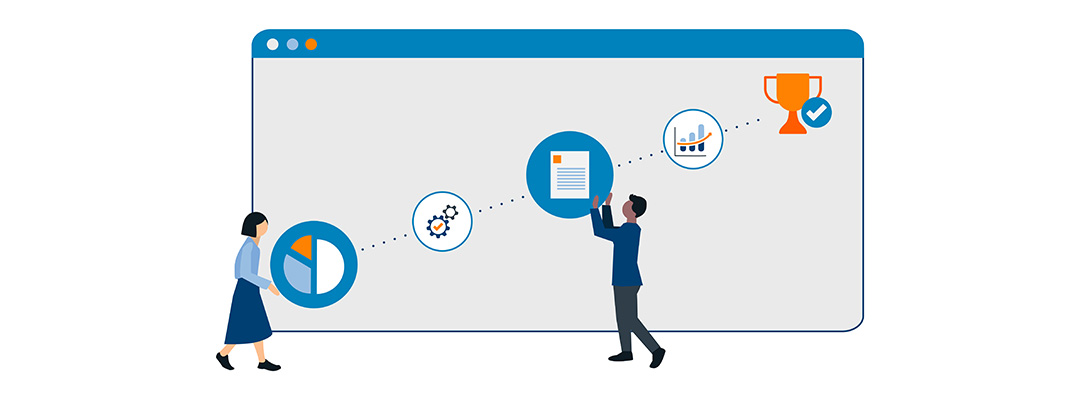When discussing strategic controlling and financial management – both inside and outside of IT – one of the terms that keeps coming up is benchmarking. You need to do benchmarking, use the proper benchmarks, and your calculations are only of use if you have taken benchmarks into consideration. However, what is often left out of these discussions is the How of the matter. What are the best practices of benchmarking? Like all strategic aspects of business operation, benchmarking is only a boon to your business, if it is properly planned, uses the right data, and is guided by the appropriate goals. In this article we have gathered all essential information on benchmarking and how you do it properly for the best outcome for your enterprise.
What is benchmarking?
A benchmark – in the context of financial management – is a key figure for comparison if you want to measure your own performance in various areas. Hence, benchmarking means using these key figures to optimize your controlling as well as general business processes.
Let us have a look at a simplified example: As a centralized IT department, you offer processes and software for your enterprise’s data security and system integrity. In order to find out how these same services you offer are priced elsewhere, you acquire benchmarking data from an external vendor. These benchmarks can tell point you to key pricing differences based on competitor, markets, or service. Based on the benchmarking results you can adjust your own pricing, analyze the sources of any found discrepancies, and optimize your overall strategy. Of course, reality looks a bit more complicated as this example might indicate.
Internal and external benchmarking
First of all, it is important to differentiate between internal and external benchmarks. As the name suggests, internal benchmarks describe the key metrics that can be used to compare and analyze services within the enterprise. For example, if your company has multiple offices across several cities and countries, it could be a worthwhile endeavor to compare, what a standard workstation costs in each location. This information can be used to develop internal benchmarks for future adjustments and planned/actual comparisons. Your office in Spain creates fewer costs than the location in Germany, despite having more employees? Benchmarks like these can help you find the root of such issues and ideally optimize your operations and cost efficiency.
External benchmarks operate closer to what was described in the first example in the section above. Usually, you would consult with an external benchmark vendor or other organizations that offer benchmarking comparisons. These firms will then provide you with benchmarking data according to your own requirements. In the realm of IT Financial Management (ITFM) it is of particular importance that you check which service levels of IT services are covered by the benchmarking data. Only then can you come to truly useful conclusion. Once you have acquired the benchmarking data, you can, for example, leverage these benchmarks to compare the pricing of your own service offering with the average market price or the pricing of your direct competitors.
Comparing the right benchmarking data
Once you have gathered the data for the internal or external benchmarking, the real challenge begins. You have to contrast these benchmarks with the corresponding internal figures in a way that yields useful conclusions and plans of action. It is important here, that you actually compare “apples to apples.” In other words: Carefully analyze the benchmarks to discern which services and service levels are covered and only compare the respective figures for the exact same services and service levels on your own end.
To illustrate the above point further, imagine this: You acquire benchmarking data for a standard workstation form an external vendor. In your own organization, a standard workstation entails – among elements like a desktop PC and an Office license – an antivirus software license. However, the benchmark you acquired does not list any sort of antivirus program, which means you cannot directly compare the data in a one-to-one manner. Make sure to take note of such discrepancies. Otherwise even high-quality benchmarks can lead to erroneous conclusions.
Guarantee transparency over internal benchmarking data
If you want to reliably avoid such errors, you need to have a clear overview over the actual service costs in your organization. In the interest of holistic (IT) financial management you should create a comprehensive service catalog that lists in detail, which IT and shared services you offer and produce, which service components and pre-products they entail, and what they cost. The right level of transparency over your service costs enables you to avoid errors during benchmarking. Part of said transparency are detailed calculations for the TCO (Total Cost of Ownership) of your services, as well as drill downs of your services to the level of single service components and primary costs. The more data you can provide on your internal operations, the easier and more fruitful the results of your benchmarking comparisons will be. Ultimately, you will be able to take targeted measures to optimize your service costing.
The right benchmarking solution
Comprehensive benchmarking comes with plenty of benefits. In the short term, you can eliminate redundancies in your expenses and in the long term you can sustainably cut costs, reinvest your (IT) budget, and optimize your overall financial management. However, calculating internal data as well as thorough benchmarking comparisons for hardware and software usually require immense effort. At the same time, even small mistakes can have far-reaching consequences and – in the worst case – can turn the entire exercise of benchmarking into a fruitless endeavor.
If you want to reduce the controlling effort for calculations and reliably avoid mistakes, you should leverage specialized benchmarking software. Serviceware Financial features a tailor-made module that digitalizes and automates all benchmarking processes: From the creation of a service catalog, over detailed service calculations, all the way to the acquisition and comparison of benchmarking data from various external sources. You can quickly and easily identify cost drivers and find the right triggers to adjust your internal cost structures and sourcing decisions.

 German
German

